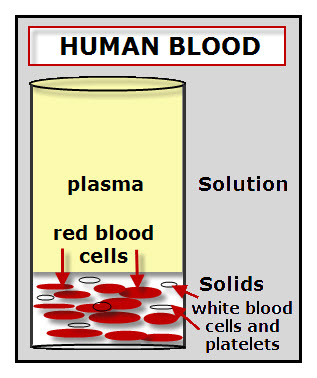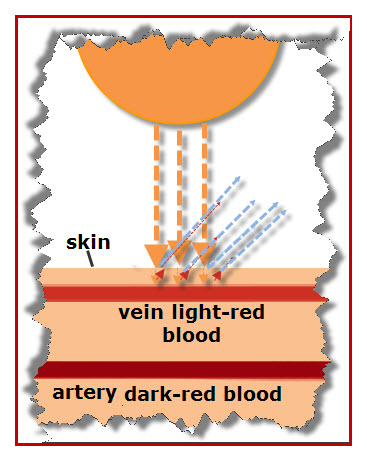 Why is Human Blood Red?
Why is Human Blood Red?
Why Do Veins Under the Skin Look Blue?
Human blood has two parts, liquid and solid.
Liquid: About 50 to 60 % of your blood is a yellowish liquid called plasma. Plasma is a solution made up of water (solvent) and solutes, such as glucose, vitamins, minerals, antibodies, and all other substances that are added to blood and are water soluble.
Solids: These are part of blood, but do not dissolve in water, thus they they remain separate from plasma. The solid parts of your blood include, colorless platelets and white blood cells, and red blood cells.
While your blood is flowing, the plasma and solids are all mixed together. The diagram shows them separated as a way to indicate that the solids are not dissolved in the plasma.
Red blood cells are red because they have hemoglobin. This iron protein is responsible for picking up oxygen in your lungs and transferring the oxygen to every cell in your body. The blood leaving your lungs has more red blood cells with attached oxygen than does the blood flowing into your lung.
Arteries: Blood vessels that carry oxygen-rich blood. These vessels carry blood away from the lungs where oxygen attaches to hemoglobin molecules. The oxygen is let off at cells. What I find amazing is that the amount of oxygen needed by the cells is what is delivered. Inactive cells need and receive less oxygen than do active cells.
Hemoglobin molecules have a red color, but hemoglobin + oxygen is redder. Thus, the more oxygenated the blood, the redder the blood.
Veins: Blood vessels that carry oxygen-poor blood and waste picked
up from cells. Veins dump its waste at different organs, such as the kidneys, which act as a filter cleaning out the bad stuff from the blood and the lungs, where the waste, carbon dioxide is removed and oxygen is picked up. The now oxygen-rich blood exits the lungs in arteries and the cycle continues.
The blood flowing through veins is red because it contains hemoglobin molecules, but not as red as the oxygen-rich blood flowing through arteries.
My skin lacks melanin (dark skin pigment), and thus is very pale. The veins near the surface of my skin are very blue. While my skin seems to be relatively transparent, it isn’t. If my skin were transparent, my veins would appear red due to the red blood flowing through them.
So, why do my veins look blue? The answer would be the same for –Why does the sky look blue? Everything that has a blue color reflects light energy with a wavelength that is perceived by your brain as some shade of blue. When light, such as sunlight hits my skin, some of the light is absorbed and some is reflected. I can see my veins because they are close enough to the surface to absorb and reflect light. The light reflected by my skin and the veins enters my eyes where light sensors called cones send messages to my brain. My brain interprets the messages and sends back the message that the skin is pale, with some brown spots (freckles but mostly what are called age spots), and thin blue lines under the skin. Some of these lines have a very pale blue color, some medium blue, and a few with a slight purple shade. 
The light striking my skin can slightly penetrate the skin. Most of this light is absorbed at or very near the skin’s surface. While all veins that are visible are reflecting light, the deeper veins receive very little light and not all of the the light these veins reflect exits the skin. The light from these veins barely stimulate the cones in your eyes, thus your brain reports that the veins are a very pale –even a blurred blue color. The opposite is true for veins close to the surface. The red light reflected from these veins plus the blue light from the skin above the veins is perceived as blue with a touch of purple.
With a bit of imagination, the diagram shows you a pink section representing pale skin with two types of blood vessels. The vessel with light-red blood is the vein, and the vessel with dark-red blood is an artery. A few red light rays are shown exiting the skin from the vein as well as blue light being reflected from the skin. The blue light basically masks the red, thus veins appear blue when viewing them through pale skin.